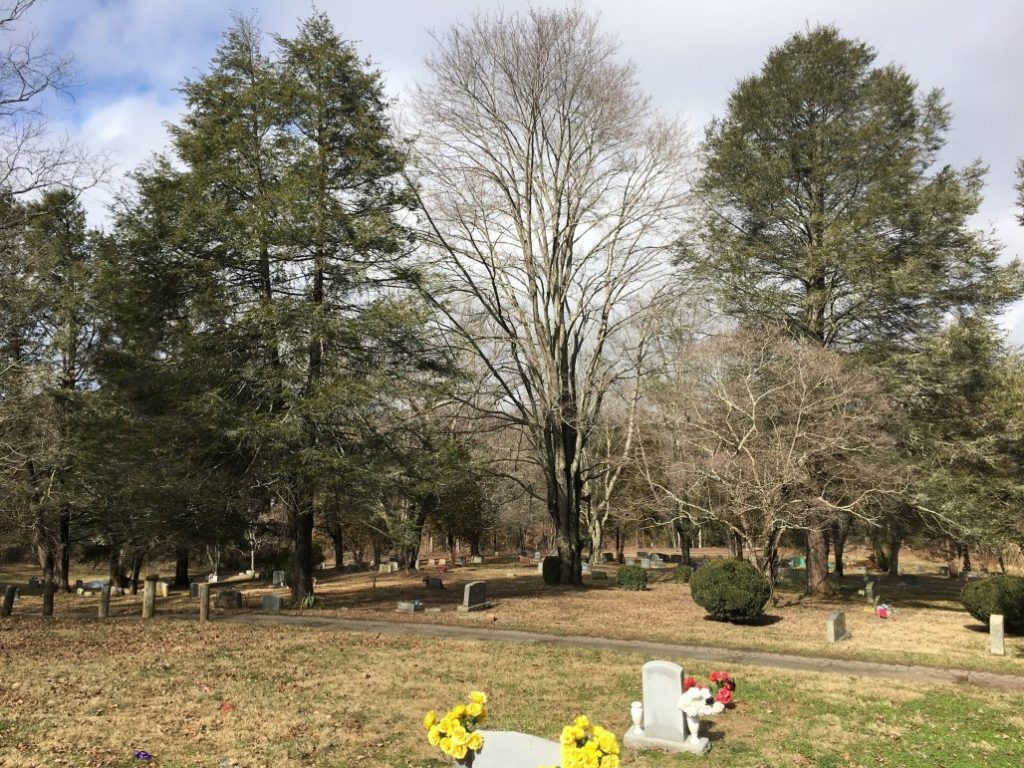Helping hemlocks, helping humans

The team that treated the hemlocks at Violet Hill Cemetery, composed of UNC-Asheville students and Hemlock Restoration Initiative staff.
Writtten by Hanusia Higgins, Guild student member
Last year, I served as an AmeriCorps member with the Hemlock Restoration Initiative of WNC Communities in Asheville, North Carolina. This small but mighty program’s mission is to protect and preserve the hemlock trees of western North Carolina from a devastating invasive pest: the hemlock woolly adelgid. I got to monitor for adelgid-eating beetles, educate landowners on how to save their trees, and treat hemlocks with chemical insecticide to protect them from the adelgid. Looking back on my yearlong term, one experience that stands out most is treating the majestic hemlocks of Violet Hill Cemetery.
Sixteen eastern hemlocks, likely centuries old, have stood sentinel over this land as the human and ecological landscapes transformed around them. In the past few decades, they have faced their own battle with the invasive woolly adelgid. On a misty day last April, students from the University of North Carolina Asheville gathered to learn from the Hemlock Restoration Initiative team and treat the hemlocks of Violet Hill Cemetery with systemic insecticide. Our actions preserved the hemlocks for at least five years to come. Hopefully, advances in biological control and other conservation techniques will ensure their long-term health.

The eastern hemlocks of Violet Hill Cemetery.
Violet Hill Cemetery, founded by Dr. L. O. Miller in 1932, is one of Asheville’s oldest African-American cemeteries. Since the days when even burial sites were segregated, it has been a serene resting place for the city’s Black community, with the large hemlock trees providing shade and tranquility. That community faced significant challenges throughout the 20th century; notably, Asheville was one of many cities to implement “urban renewal” projects in the 1950s -1970s, dividing and destroying predominantly Black neighborhoods to build new infrastructure. The construction of Patton Avenue severed Violet Hill Cemetery’s link to the nearby Burton Street Community. Today it bears witness to more strife, as the Asheville Police Department destroys medical supplies of community members protesting the murder of George Floyd and the widespread police brutality against Black Americans.

UNCA students prepare to treat an eastern hemlock with chemical insecticide to protect it from the hemlock woolly adelgid.
The fates of hemlocks and of humans are inextricably intertwined. These trees provide us with clean air, cool water, and countless other services. In return, we unknowingly introduced a pest that may lead to their demise, but we may also be their only chance at survival. On a larger scale, environmental protection is inseparable from racial justice. The history of racism in America has shaped every facet of our country, and the fields of forestry and conservation are not excepted from the racism that continues to this day. Like many others, I have been deeply affected by the protests and resurgence of the Black Lives Matter movement in the past few weeks. As fervently as I advocate and take action for ecological protection and curbing climate change, I must and I will show the same passion in working towards racial justice. In doing so, I hope to honor the legacy of the hemlocks at Violet Hill Cemetery.
About the author: Hanusia Higgins is a student member of the Guild, and a master’s student at the University of Vermont’s Rubenstein School of Environment and Natural Resources. She is studying the impacts of the emerald ash borer and of the management response to it on northern hardwood forests.
